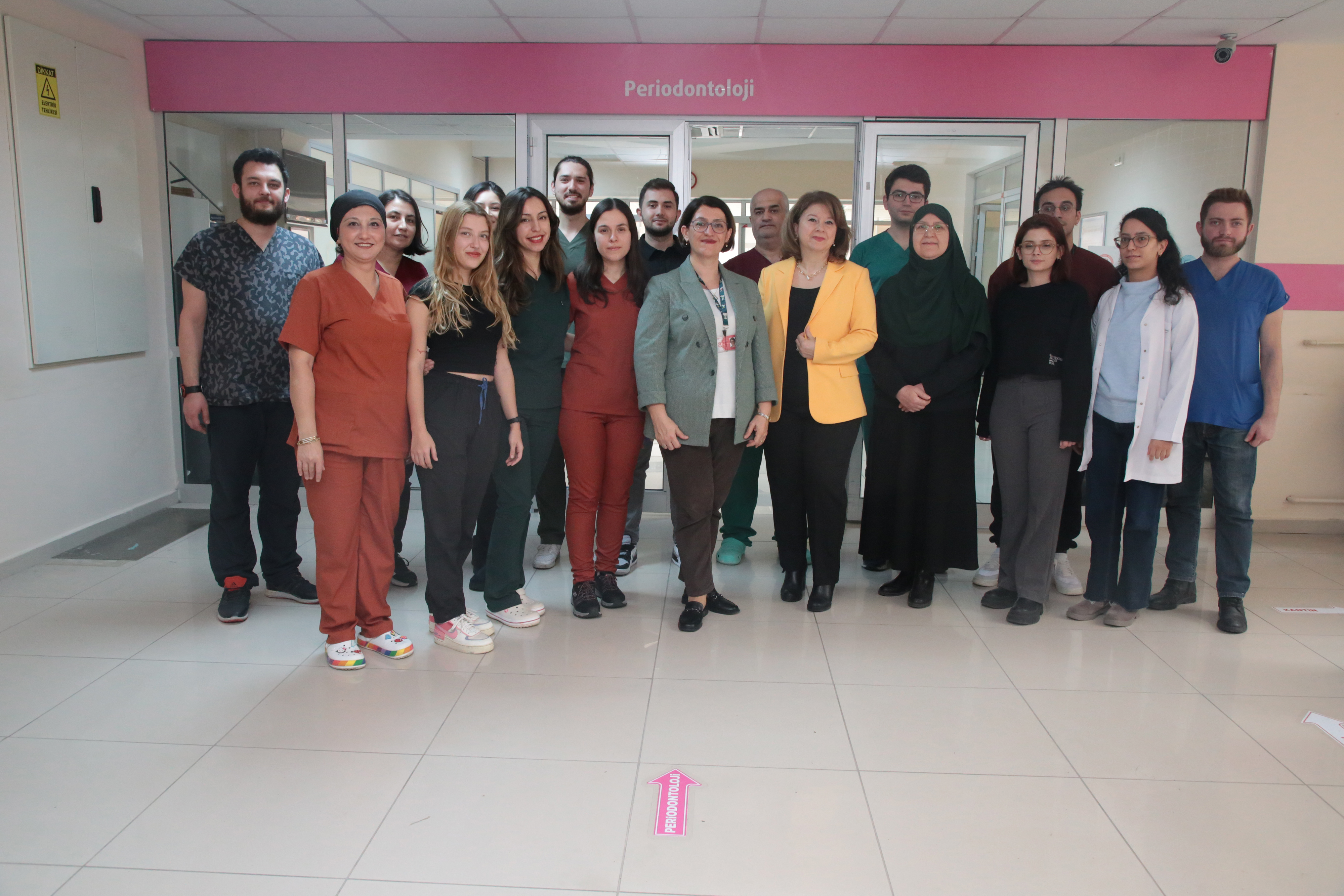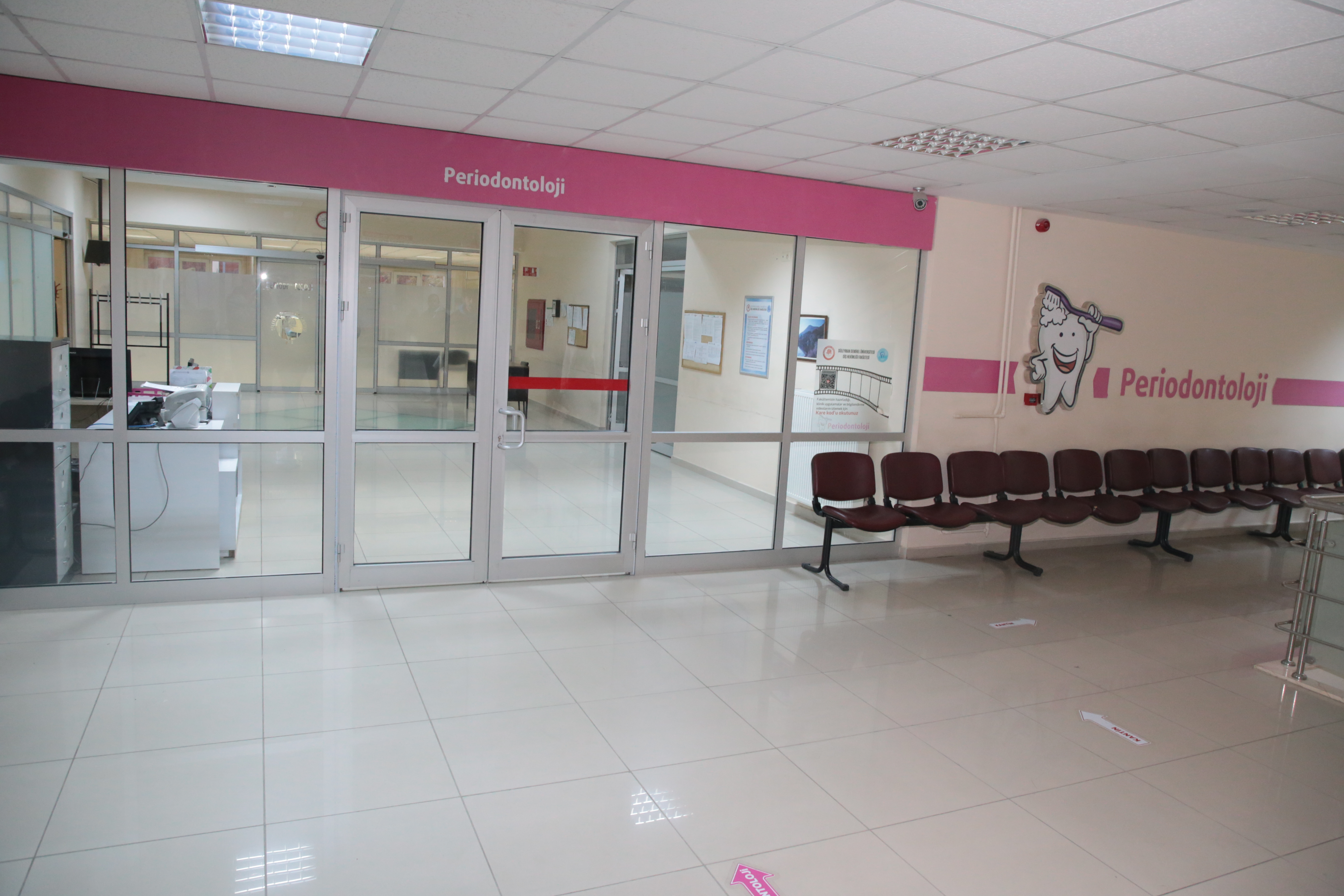Periodontology
|
Chair Prof. Dr. Zuhal Yetkin AY Academic Staff Assoc. Prof. Dr. Ahmet Mert NALBANTOĞLU Research Assistant Berfin Ceren KARAKUŞ Research Assistant Osman Buğra VAROL Research Assistant Kerem HAYTA Research Assistant Meryem KÖKSALAN Research Assistant Nazlıcan AYDIN Research Assistant Elif AKBULUT Research Assistant Ömer EROĞLU Research Assistant Aslı Ege ÖZDAMAR
Communication 0246 211 32 49 |
HISTORY The Department of Periodontology was founded in 1997 by Prof.Dr. F.Yeşim Kırzıoğlu.
LOCATION AND CAPACITY In our department, there is a student and an assistant clinic and an operating room where surgical applications are made.
RESEARCH ASSISTANT TRAINING PROCESS Research assistant training period is 3 years. During this training period, rotations are made in the Faculty of Medicine, Department of Anesthesiology and Reanimation and the Faculty of Dentistry, Department of Oral and Maxillofacial Surgery. Every week, lectures, seminars and case discussions are held within the scope of the specialty training program in dentistry.
DEPARTMENT OF STUDY AREAS Diagnosis and treatment of periodontal diseases Relationship between systemic diseases and periodontal disease Dental implants Diagnosis and treatment of periimplant diseases
OPPORTUNITIES Student and assistant clinic Local operating room
TREATMENTS APPLIED IN THE DEPARTMENT 1. Non-surgical periodontal treatment -Scaling cleaning and root surface straightening: It is the process of removing hard and soft attachments on tooth surfaces. -Subgingival curettage: It is the process of removing the appendages and inflammatory tissues around the teeth by anesthetizing the teeth and gums in order to eliminate the inflammatory condition in the gingiva or to prepare the tissues for advanced periodontal treatment.
2. Surgical periodontal treatment -Periodontal flap surgery: It is the process of cleaning the root surface and inflamed tissues by anesthetizing the teeth and gums in cases where gingival disease progresses, lifting the gingival bone surface to expose the bone surface. -Gingivectomy and gingivoplasty: It is the surgical removal and shaping of the gums by anesthetizing for the treatment of gingival enlargements. -Frenectomy: It is the surgical removal of the muscle connection by anesthetizing the gingiva, which is applied when the muscle connection called frenulum is positioned closer to the tooth than where it should normally be. -Resective and regenerative bone surgery: It is the process of shaping the bone around the teeth during periodontal flap surgery in cases where gingival disease progresses or supporting the bone with various graft materials when appropriate -Soft tissue graft applications: It is the process of surgically placing soft tissue taken from another part of the mouth to the area to be treated in order to treat existing gingival recession or prevent future recessions. -Pre-prosthetic periodontal surgery applications
3. Implant applications: It is the process of placing an artificial tooth root, usually made of titanium, into the jawbone for the treatment of tooth deficiencies 4. Treatment of diseases around implants: Gum disease can occur around implants as well as in natural teeth. In this case, peri-implant diseases are also treated with surgical or non-surgical methods. 5. Laser applications: Laser in periodontal treatment; It is applied for cutting tissues, removing dark colors in the gingiva, treating herpes and aphthae, stopping bleeding, treating hot-cold sensitivity in teeth, and treating gingival and implant-related diseases.
MOST FREQUENTLY ASKED QUESTIONS 1. What is gum disease? Gum disease is an inflammatory disease that occurs in the gums and other tissues that support the teeth around the teeth.
2. Why does gum disease occur? - The main cause of gum diseases is bacterial plaque accumulating on tooth surfaces. Individual's immune response and risk factors such as smoking, diabetes and stress are among the effective factors in periodontal tissue loss.
3. What are the symptoms of gum disease? Gingival bleeding that occurs during brushing or spontaneously, redness, swelling and tenderness in the gingiva, swaying of the teeth and the beginning of the teeth to move away from each other are the symptoms of gingival disease.
4. Does gum disease affect general health? Microorganisms that cause gum disease and the harmful substances they produce can cause some health problems such as heart diseases, diabetes, respiratory tract and lung diseases, and the risk of low-weight birth or premature birth.
5. Does the general health condition or the medications used affect the gum disease? Health conditions such as diabetes, immune system-related diseases, hormonal changes and some medications can affect gum disease.
6. What happens when gum disease is not treated? -Gingival diseases progress unless treated and tooth loss may occur in the last stage of the disease.
7. How does calculus form, is calculus cleaning harmful? As a result of insufficient removal of the bacterial plaque accumulated on the tooth surfaces, calculus occurs when some minerals in the saliva precipitate on the dental plaque. When done correctly with appropriate tools, tartar cleaning is not a harmful application for teeth.
8. How long does the treatment of gum disease take? Depending on the severity of the gum disease, the duration of treatment for gum disease varies.
9. Does smoking affect gum disease? It is known that smoking increases the severity of gingival disease and decreases tissue response to treatment.
10. How can we protect our oral and dental health? Oral and dental health can be maintained by brushing the teeth twice a day, as well as using toothpaste, mouthwashes, dental floss or an interface brush.
11. What are the features of the ideal toothbrush? Although the design of the ideal toothbrush varies from person to person, a medium or soft brush with a flat handle and smooth surface that can reach all parts of the mouth can be used.
Informed Consent Forms Anamnesis Informed Consent Form Biomaterials Applications Informed Consent Form Flap Operation Informed Consent Form Gingivectomy Operation Informed Consent Form Hemisection-Root Amputation Informed Consent Form Laser Applications Informed Consent Form Membrane Application Informed Consent Form Night Guard Informed Consent Form Periodontal Abscess Informed Consent Form Phrenotomy and Phrenectomy Operations Informed Consent Form Platelet Rich Applications Informed Consent Form Scaling and Root Planning Informed Consent Form |


